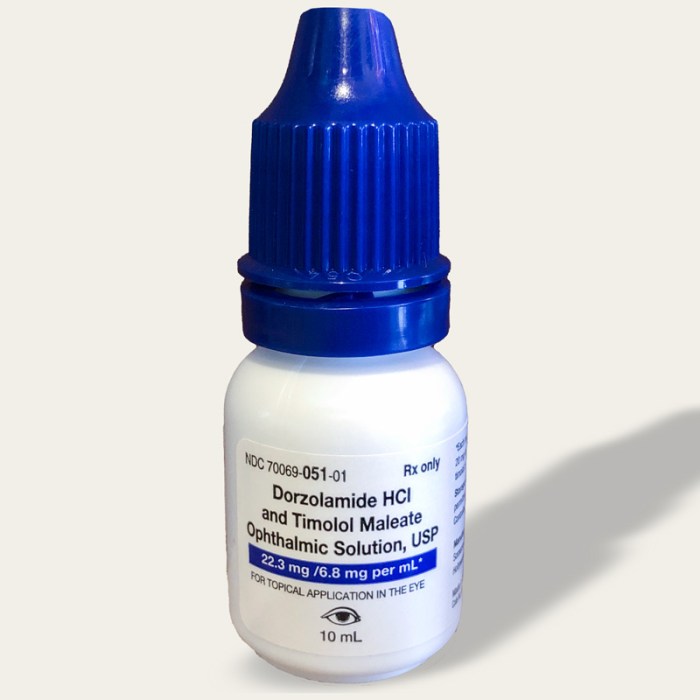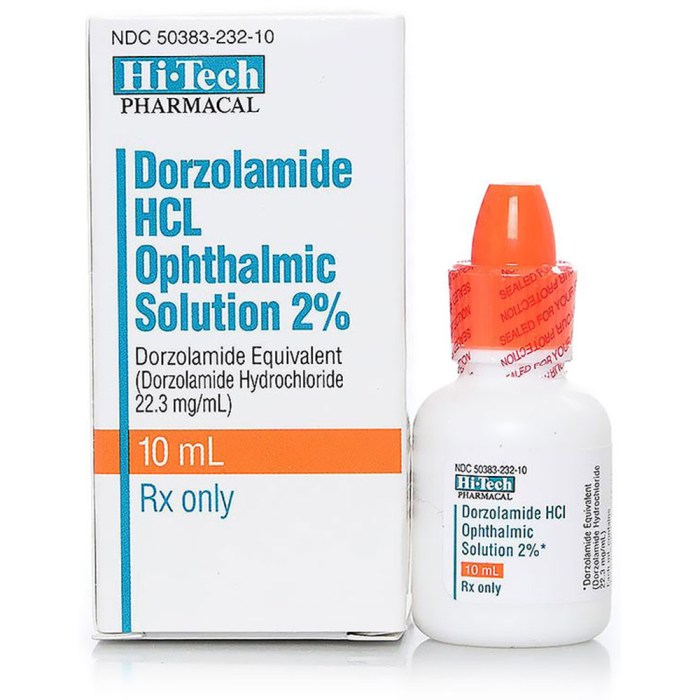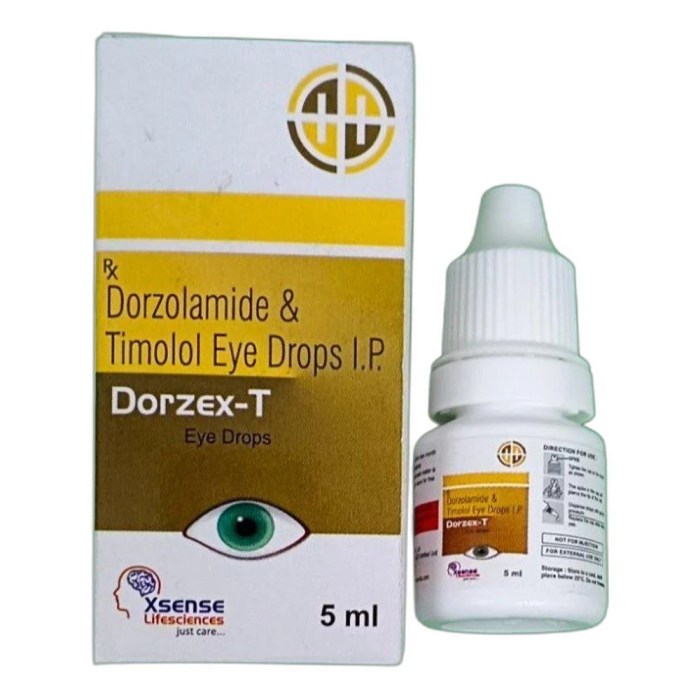Dorzolamide timolol is a powerful combination medication used to lower intraocular pressure (IOP) in patients with open-angle glaucoma and ocular hypertension. This unique drug combines the strengths of two different classes of medications, a carbonic anhydrase inhibitor (dorzolamide) and a beta-blocker (timolol), to effectively manage IOP and prevent vision loss.
This comprehensive overview delves into the mechanism of action, pharmacokinetics, clinical applications, safety considerations, and patient education related to dorzolamide timolol. We will explore its effectiveness in treating glaucoma, discuss potential side effects, and provide insights into its proper use and administration.
Comparison with Other Glaucoma Medications

Dorzolamide timolol is a combination medication used to treat glaucoma, a condition that damages the optic nerve, which connects the eye to the brain. It is often prescribed when other medications are not effective in lowering eye pressure. However, it is important to understand how dorzolamide timolol compares to other commonly used glaucoma medications, as well as their advantages and disadvantages.
Comparison of Dorzolamide Timolol with Other Glaucoma Medications
The choice of glaucoma medication for an individual patient depends on several factors, including the severity of the condition, the patient’s medical history, and their tolerance to different medications. Here is a comparison of dorzolamide timolol with other commonly used glaucoma medications:
Prostaglandin Analogs
- Advantages: Prostaglandin analogs, such as latanoprost, bimatoprost, and travoprost, are generally considered the most effective class of medications for lowering eye pressure. They are well-tolerated and have a low risk of side effects. They can also be used once a day, which is convenient for patients.
- Disadvantages: Prostaglandin analogs can cause eye irritation, redness, and darkening of the iris (the colored part of the eye). They can also cause eyelash growth.
Beta-Blockers
- Advantages: Beta-blockers, such as timolol, betaxolol, and carteolol, are effective in lowering eye pressure and are generally well-tolerated. They are available as eye drops and are typically used once or twice a day.
- Disadvantages: Beta-blockers can cause systemic side effects, such as slow heart rate, low blood pressure, and breathing problems. They should be used with caution in patients with asthma, heart disease, or other medical conditions.
Alpha-2 Agonists
- Advantages: Alpha-2 agonists, such as brimonidine and apraclonidine, are effective in lowering eye pressure and can be used once or twice a day. They are generally well-tolerated, although some patients may experience eye irritation or redness.
- Disadvantages: Alpha-2 agonists can cause dry mouth, drowsiness, and fatigue. They should be used with caution in patients with depression or other mental health conditions.
Carbonic Anhydrase Inhibitors
- Advantages: Carbonic anhydrase inhibitors, such as dorzolamide and brinzolamide, are effective in lowering eye pressure. They are available as eye drops and are typically used two to three times a day.
- Disadvantages: Carbonic anhydrase inhibitors can cause eye irritation, redness, and stinging. They can also cause systemic side effects, such as kidney stones, fatigue, and taste disturbances.
Other Medications
- Advantages: Other medications, such as epinephrine and pilocarpine, are sometimes used to treat glaucoma. They are effective in lowering eye pressure and can be used as eye drops.
- Disadvantages: Epinephrine can cause eye irritation, redness, and brown pigmentation of the iris. Pilocarpine can cause blurred vision, headaches, and sweating.
Factors Influencing the Choice of Medication
The choice of glaucoma medication is a complex decision that should be made by an ophthalmologist. Several factors are considered, including:
- Severity of the condition: For patients with mild glaucoma, eye drops may be sufficient. For patients with more severe glaucoma, laser surgery or other treatments may be necessary.
- Patient’s medical history: Patients with certain medical conditions, such as asthma, heart disease, or kidney disease, may not be able to tolerate certain medications.
- Patient’s tolerance to medications: Some patients may experience side effects from certain medications, while others may tolerate them well.
- Cost of medication: Some medications are more expensive than others. The cost of medication should be considered when making a treatment decision.
- Convenience of medication: Some medications need to be used multiple times a day, while others can be used once a day. The convenience of medication should be considered when making a treatment decision.
Research and Development

Dorzolamide timolol, a fixed-combination medication for glaucoma, has been extensively studied, and ongoing research continues to explore its efficacy, safety, and potential applications.
Recent Research Findings on Efficacy and Safety
Research on dorzolamide timolol has consistently demonstrated its efficacy in lowering intraocular pressure (IOP), a primary goal in managing glaucoma. Studies have shown that dorzolamide timolol is effective in reducing IOP, particularly in patients with open-angle glaucoma or ocular hypertension. Moreover, dorzolamide timolol has been found to be well-tolerated by most patients, with a relatively low incidence of adverse effects.
Ongoing Research Efforts to Improve Delivery and Efficacy
Researchers are actively exploring ways to enhance the delivery and efficacy of dorzolamide timolol. One area of focus is developing novel drug delivery systems that improve the bioavailability of the medication. For instance, studies are investigating the use of nanotechnology to encapsulate dorzolamide timolol, potentially leading to sustained release and improved efficacy.
Potential Future Applications of Dorzolamide Timolol in Ophthalmology
While primarily used for glaucoma, dorzolamide timolol’s potential applications in ophthalmology extend beyond IOP reduction. Researchers are exploring its use in other eye conditions, such as dry eye disease, where its ability to reduce inflammation may be beneficial.
Patient Education and Counseling

Dorzolamide timolol is a medication used to treat high pressure in the eye (glaucoma). It is a combination of two medications: dorzolamide and timolol. Dorzolamide is a carbonic anhydrase inhibitor, and timolol is a beta-blocker. Both medications work to lower eye pressure by reducing the production of fluid in the eye.
Understanding Dorzolamide Timolol
Dorzolamide timolol is a prescription medication that comes in the form of eye drops. It is typically used once or twice a day. It is important to use this medication exactly as prescribed by your doctor. Do not use more or less than directed, and do not stop using it without talking to your doctor.
Frequently Asked Questions
This section provides answers to common questions about dorzolamide timolol.
- What are the possible side effects of dorzolamide timolol?
Common side effects include burning, stinging, and redness of the eye. Less common side effects include blurred vision, headache, and dry eyes. In rare cases, dorzolamide timolol can cause more serious side effects, such as allergic reactions, heart problems, and breathing problems. If you experience any unusual or severe side effects, contact your doctor immediately. - Who should not use dorzolamide timolol?
Dorzolamide timolol should not be used by people who are allergic to dorzolamide, timolol, or any of the ingredients in the medication. It should also not be used by people with certain medical conditions, such as asthma, heart problems, or severe liver problems. If you have any questions about whether or not dorzolamide timolol is right for you, talk to your doctor. - How should I store dorzolamide timolol?
Store dorzolamide timolol at room temperature, away from heat and light. Do not freeze it. Keep the bottle tightly closed when not in use. - What should I do if I miss a dose of dorzolamide timolol?
If you miss a dose of dorzolamide timolol, apply it as soon as you remember. However, if it is almost time for your next dose, skip the missed dose and apply the next dose at the regular time. Do not double the dose to make up for a missed dose.
Communicating with Patients
When communicating with patients about dorzolamide timolol, it is important to:
- Explain the medication’s purpose and how it works. Patients should understand why they are taking the medication and how it will help them. Use clear and simple language that they can understand.
- Discuss potential side effects and how to manage them. Be upfront about the possible side effects of the medication and how to manage them. This will help patients feel more prepared and less anxious about potential problems.
- Answer any questions patients may have. Encourage patients to ask questions and address their concerns openly and honestly. This will help build trust and ensure that patients are comfortable with their medication.
- Provide written instructions. Give patients a written copy of the medication instructions, including dosage, frequency, and any other important information. This will help them remember the information and refer to it later.
Cost Considerations and Accessibility
Dorzolamide timolol, like many other glaucoma medications, can have varying costs depending on factors like insurance coverage, pharmacy location, and generic availability. Understanding these cost considerations and potential strategies to improve accessibility is crucial for patients seeking effective glaucoma management.
Cost Comparison with Other Glaucoma Medications
The cost of dorzolamide timolol can be compared to other glaucoma medications based on their dosage form, frequency of administration, and brand name versus generic availability. For example, dorzolamide timolol eye drops, available as a generic, are often more affordable than newer medications like prostaglandin analogs, which may be available only as brand-name products.
Strategies to Improve Accessibility
Several strategies can be implemented to enhance the accessibility of dorzolamide timolol for patients:
- Generic Availability: Promoting the use of generic dorzolamide timolol can significantly reduce medication costs.
- Patient Assistance Programs: Pharmaceutical companies often offer patient assistance programs (PAPs) to help low-income individuals afford their medications, including dorzolamide timolol.
- Prescription Drug Discount Programs: Various discount programs, such as GoodRx, can provide significant savings on prescription medications, including dorzolamide timolol.
- Negotiation with Insurance Companies: Healthcare providers can negotiate with insurance companies to secure lower co-pays or preferred formulary status for dorzolamide timolol.
Impact of Insurance Coverage
Insurance coverage plays a significant role in determining the affordability of dorzolamide timolol.
- Formulary Coverage: If dorzolamide timolol is included in a patient’s insurance formulary, the co-pay may be lower than for medications not on the formulary.
- Prior Authorization: Some insurance plans may require prior authorization before covering dorzolamide timolol, which can delay access to the medication.
- Co-pay Assistance Programs: Insurance companies may offer co-pay assistance programs to help patients afford their medications, including dorzolamide timolol.
Conclusion: Dorzolamide Timolol
Dorzolamide timolol, a fixed-combination medication, stands as a cornerstone in the management of glaucoma and ocular hypertension. Its dual-mechanism action, effectively lowering intraocular pressure (IOP) by inhibiting aqueous humor production and increasing outflow, makes it a valuable tool for ophthalmologists and patients alike.
This discussion has highlighted the efficacy, safety, and practicality of dorzolamide timolol in achieving IOP reduction and mitigating the risk of vision loss.
Importance of Dorzolamide Timolol in Glaucoma Management
Dorzolamide timolol’s significance lies in its ability to:
- Provide effective IOP reduction, often exceeding the effects of monotherapy.
- Enhance patient compliance by simplifying treatment regimens.
- Minimize the potential for side effects associated with single-agent therapy.
Ongoing Research and Patient Education
The continuous evolution of glaucoma treatment necessitates ongoing research and patient education. Research efforts are focused on:
- Developing novel drug formulations for enhanced efficacy and convenience.
- Exploring alternative drug delivery methods to improve patient adherence.
- Investigating the long-term effects of dorzolamide timolol on ocular health.
Patient education is crucial to ensure optimal medication adherence and disease management. Key aspects of patient education include:
- Understanding the importance of regular eye exams and IOP monitoring.
- Proper administration techniques for topical eye drops.
- Recognizing potential side effects and reporting them promptly.
- Adopting a healthy lifestyle to manage glaucoma risk factors.
Dorzolamide timolol stands as a valuable tool in the management of glaucoma and ocular hypertension, offering a dual-pronged approach to IOP reduction. By understanding its mechanism of action, potential benefits, and risks, healthcare professionals can effectively utilize this medication to improve patient outcomes. Ongoing research continues to explore new applications and enhance the efficacy of this important therapeutic option.
Dorzolamide timolol is a combination medication used to treat high pressure inside the eye (ocular hypertension) and a type of glaucoma called open-angle glaucoma. It’s important to note that this medication is not the same as medications like herceptin , which is used to treat certain types of breast cancer. While both medications have different applications, they are both examples of how medical advancements have provided solutions for various health conditions.